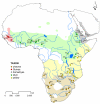Mitochondrial phylogeography of baboons (Papio spp.): indication for introgressive hybridization?
- PMID: 19389236
- PMCID: PMC2681462
- DOI: 10.1186/1471-2148-9-83
Mitochondrial phylogeography of baboons (Papio spp.): indication for introgressive hybridization?
Erratum in
-
Correction to: Mitochondrial phylogeography of baboons (Papio spp.) - Indication for introgressive hybridization?BMC Evol Biol. 2019 Nov 4;19(1):198. doi: 10.1186/s12862-019-1537-6. BMC Evol Biol. 2019. PMID: 31684855 Free PMC article.
Abstract
Background: Baboons of the genus Papio are distributed over wide ranges of Africa and even colonized parts of the Arabian Peninsula. Traditionally, five phenotypically distinct species are recognized, but recent molecular studies were not able to resolve their phylogenetic relationships. Moreover, these studies revealed para- and polyphyletic (hereafter paraphyletic) mitochondrial clades for baboons from eastern Africa, and it was hypothesized that introgressive hybridization might have contributed substantially to their evolutionary history. To further elucidate the phylogenetic relationships among baboons, we extended earlier studies by analysing the complete mitochondrial cytochrome b gene and the 'Brown region' from 67 specimens collected at 53 sites, which represent all species and which cover most of the baboons' range.
Results: Based on phylogenetic tree reconstructions seven well supported major haplogroups were detected, which reflect geographic populations and discordance between mitochondrial phylogeny and baboon morphology. Our divergence age estimates indicate an initial separation into southern and northern baboon clades 2.09 (1.54-2.71) million years ago (mya). We found deep divergences between haplogroups within several species (~2 mya, northern and southern yellow baboons, western and eastern olive baboons and northern and southern chacma baboons), but also recent divergence ages among species (< 0.7 mya, yellow, olive and hamadryas baboons in eastern Africa).
Conclusion: Our study confirms earlier findings for eastern Africa, but shows that baboon species from other parts of the continent are also mitochondrially paraphyletic. The phylogenetic patterns suggest a complex evolutionary history with multiple phases of isolation and reconnection of populations. Most likely all these biogeographic events were triggered by multiple cycles of expansion and retreat of savannah biomes during Pleistocene glacial and inter-glacial periods. During contact phases of populations reticulate events (i.e. introgressive hybridization) were highly likely, similar to ongoing hybridization, which is observed between East African baboon populations. Defining the extent of the introgressive hybridization will require further molecular studies that incorporate additional sampling sites and nuclear loci.
Figures




References
-
- Kaessmann H, Wiebe V, Pääbo S. Extensive nuclear DNA sequence diversity among chimpanzees. Science. 1999;286:1159–1162. - PubMed
-
- Holliday TW. Species concepts, reticulation, and human evolution. Curr Anthropol. 2003;44:653–660.
-
- Pääbo S. The mosaic that is our genome. Nature. 2003;421:409–412. - PubMed
-
- Patterson N, Richter DJ, Gnerre S, Lander ES, Reich D. Genetic evidence for complex speciation of humans and chimpanzees. Nature. 2006;441:1103–1108. - PubMed
Publication types
MeSH terms
Substances
Associated data
- Actions
- Actions
- Actions
- Actions
- Actions
- Actions
- Actions
- Actions
- Actions
- Actions
- Actions
- Actions
- Actions
- Actions
- Actions
- Actions
- Actions
- Actions
- Actions
- Actions
- Actions
- Actions
- Actions
- Actions
- Actions
- Actions
- Actions
- Actions
- Actions
- Actions
- Actions
- Actions
- Actions
- Actions
- Actions
- Actions
- Actions
- Actions
- Actions
- Actions
- Actions
- Actions
- Actions
- Actions
- Actions
- Actions
- Actions
- Actions
- Actions
- Actions
- Actions
- Actions
- Actions
- Actions
- Actions
- Actions
- Actions
- Actions
- Actions
- Actions
- Actions
- Actions
- Actions
- Actions
- Actions
- Actions
- Actions
- Actions
- Actions
- Actions
- Actions
- Actions
- Actions
- Actions
- Actions
- Actions
- Actions
- Actions
- Actions
- Actions
- Actions
- Actions
- Actions
- Actions
- Actions
- Actions
- Actions
- Actions
- Actions
- Actions
- Actions
- Actions
- Actions
- Actions
- Actions
- Actions
- Actions
- Actions
- Actions
- Actions
- Actions
- Actions
- Actions
- Actions
- Actions
- Actions
- Actions
- Actions
- Actions
- Actions
- Actions
- Actions
- Actions
- Actions
- Actions
- Actions
- Actions
- Actions
- Actions
- Actions
- Actions
- Actions
- Actions
- Actions
- Actions
- Actions
- Actions
- Actions
- Actions
- Actions
- Actions
- Actions
- Actions
- Actions
- Actions
- Actions
LinkOut - more resources
Full Text Sources
Miscellaneous

